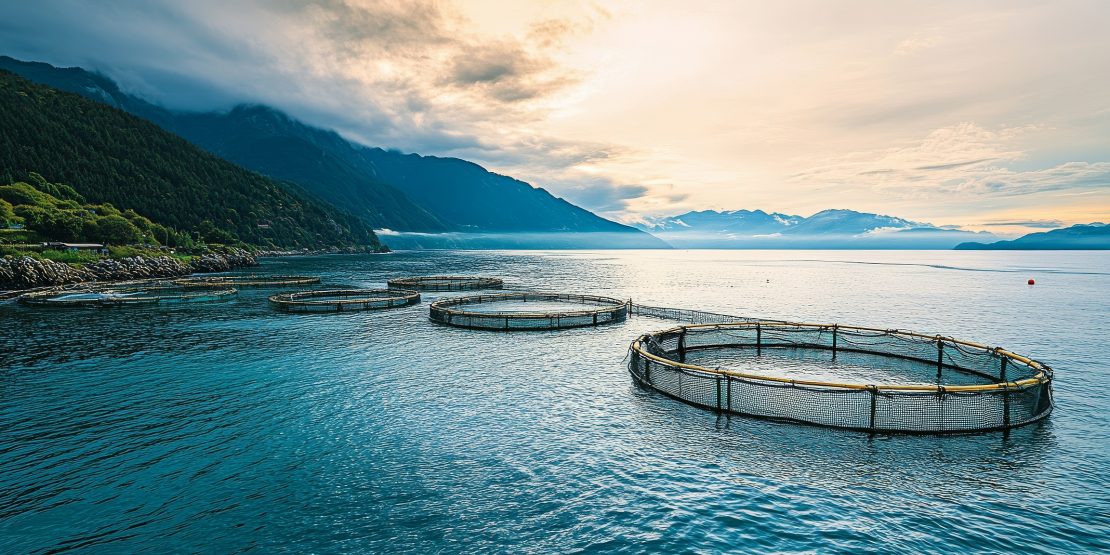
In the European Union alone, around 1.08 million tonnes of the pink edible fish were consumed in 2023. This makes the EU the world’s largest sales market for salmon. Most salmon today are bred on farms. These are huge nets that are anchored to the seabed and provide space for up to one million fish. These salmon farms are a special form of aquaculture for producing fish under controlled conditions. Around 70 per cent of the salmon traded worldwide today comes from such aquacultures, most of which are located in the Norwegian fjords or off the Chilean coast.
But it is precisely this type of factory farming that makes the salmon louse feel particularly at home there. The marine parasite impairs the health of the salmon, causes major damage and results in higher costs. The salmon louse is a tiny cancer that lives on the outside of its host and feeds on the host’s mucus, skin and blood. Experts estimate the costs of preventive measures, treatment and losses at several hundred million euros per year. They can account for up to 10 per cent of total production costs.
To minimise these financial losses, the Norwegian company Harbor AS has developed a robust and now patented preventive solution against salmon lice called Harbor Fence. Verifications and pilot tests were carried out in large commercial facilities between 2015 and 2019. Harbor has tested a successful technical and mechanical verification over two generations of salmon in commercial pilot plants, which was completed in spring 2020.

Research has shown that lice larvae lose their ability to attach to salmon when exposed to small electromagnetic fields. Harbor Fence utilises this effect through an enclosing electromagnetic field that is stretched around the cage. The field takes the form of an open fence and neutralises the lice larvae on their way into the cage. Harbor Fence is now in commercial operation and supplies several customers along the entire Norwegian coast. Installation and service are carried out by our own teams.
In addition, a good flow of water helps to neutralise the lice larvae produced in the cage when they emerge from the harbour fence system. This helps to reduce the infection of neighbouring cages, other sites and wild salmon. Harbor Fence has a localised effect and does not harm the fish within the aquaculture.
Harbor AS enlisted the expertise of LAPP Norway to develop this solution. Together with LAPP Muller and the LAPP Engineering & Advanced Technology department, the Norwegian specialists developed a special electrode cable. This was used to construct a kind of “fence” of thin electrodes that are attached around the outside of the entire net pen.

The electrode specially developed by LAPP is a semi-conductive power cable that conducts electricity and forms an electromagnetic field or barrier. By hanging the electrodes in a row one behind the other, they form an electromagnetic open fence and an open-air protection that acts as an external fuse. “The challenge was to design the cables in such a way that they could withstand seawater without losing significant effectiveness during their intended service life,” says Lars Nilsen, Product Manager at LAPP Norway. LAPP Norway has already supplied more than 130 kilometres of electrodes for such salmon fences.
The electrodes, which hang in the sea at a distance of 12-17 centimetres outside the net, are connected to control cabinet. The control cabinet controls the frequency and length of the pulses sent via the electrodes and continuously transmits real-time data on the state of the sea as a basis for optimisation, monitoring and control. Normal net pens today are equipped with two automation and control boxes. A Harbour Fence installation has an annual power consumption of 9,000 kWh. The standard depth for a Harbour Fence system installation is 10 metres. Harbour Fence is just as suitable for plastic cages as it is for steel cages. The company concludes service contracts with its customers and ensures that the fence functions properly. Harbor also takes care of returns and the repair or replacement of the system if necessary.
In addition, a remote monitoring solution can provide hydrographic data such as salinity, temperature and current velocity in real time. This data can be used to optimise the current pulse and current consumption in the fence. The systems are constantly being further developed, as are the electrode materials used.
Demand for Harbor Fence is high. Christian Eritzland, Project Manager at Harbor: “We have also received international enquiries from Canada, Chile and Scotland. We are continuously working on product development and are pursuing several interesting avenues. Some of these involve simpler assembly and disassembly as well as remote monitoring and control of the control cabinets.” This would also allow such a system to warn of other undesirable events, such as acute contamination or increasing algae growth. “If the lice do get into the cages, complementary solutions such as cleaner fish and lasers can work well with the electric fence. Together with cleaner fish or lasers, the system is a very important measure against lice that is not only environmentally friendly but also cost-effective,” explains Fritzland.
By the way: The system poses no risk to the health of the salmon! The voltage is very low. In addition, the system is attached to the outside of the net enclosure.
